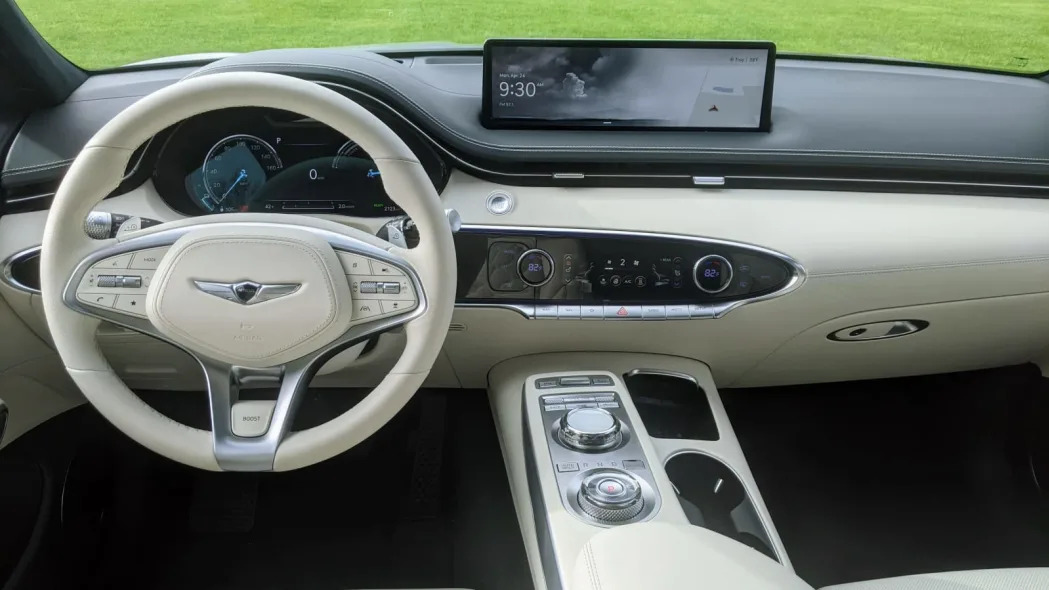Pros: Class-leading interior; comfortable ride; excellent tech; safety scores; standard AWD; available as an EV
Cons: Handles like a big, heavy SUV; smallish second row; modest electric range; steering is acceptable, but gets worse in Sport mode
The 2024 Genesis GV70 is a handsome and comfortable compact luxury crossover with a lot to love. It offers two potent turbocharged engines, as well as a battery-electric powertrain in the Genesis Electrified GV70. It’s full of excellent technology, including a robust and easy-to-use suite of safety features. Genesis might not have the brand cachet of its German counterparts, but its quality and excellent interior makes it a mighty challenger for the likes of Mercedes and Audi, albeit with lower pricing.
And while it might not be quite as nimble as the competition on a winding road, it compensates for that with a refined ride, which is made even better with an adaptive suspension that reads and adjusts to the road ahead. For an even more serene experience, the Electrified GV70 offers near-complete silence while still packing quite the accelerative punch when you dig into the right pedal. Its estimated range of 236 miles is unimpressive, though, even if its recharging capabilities are exceptional.
One drawback for every GV70 is the surprisingly tight second row of seating, which makes it a little cramped for adults with long legs or kids in car seats. It helps to make up for that shortcoming, though, with fairly generous cargo volume.
Regardless of what you’re looking for in a small SUV, the 2024 Genesis GV70 is definitely worth cross-shopping if you’re exploring the segment, even if you’ve never heard of it before.
Interior & Technology | Passenger & Cargo Space | Performance & Fuel Economy
What it’s like to drive | Pricing & Trim Levels | Crash Ratings & Safety Features
What’s new for 2024?
The GV70 mostly carries over for 2024, with a few minor changes:
All trims get a Wi-Fi hotspot. Pricing gets some updates, as noted in the price section further below.
The 2.5T AWD gets standard 19-inch wheels and monobloc front brakes. The Sport Prestige package gets ventilated front seats, Lexicon premium audio, manual rear door shades and remote smart parking assist as standard equipment. The 3.5T AWD gets Forward Collision-Avoidance Assist 2 and Highway Driving Assist 2 (more on those in the safety section, further below) as standard equipment. The Sport Advanced package now offers optional 21-inch Sport alloy wheels.
The Electrified GV70 drops the Makalu Gray Matte exterior paint option, but adds Uyuni White, Alta White, Matterhorn White, Capri Blue and Cardiff Green as available colors.
What are the GV70 interior and in-car technology like?
The GV70 interior is a true delight, with the Sport Advanced package providing a luxury feel second to none in the segment. Its Nappa leather seating, buttery-soft leatherette on the upper dash and door panels, and a suede headliner are show stoppers. The buttons move with a rich fluidity, and the touch-sensitive controls for a select number of infrequently used climate controls provide a modern, decluttered look without infuriating functionality. The two knobs on the center console that control the infotainment system and gear selection are also high-quality pieces, resembling fine crystal. They look different and have different textures, but unfortunately, they’re also virtually the same size and placed next to each other. You may end up changing a radio station when you really meant to put the car in Drive. Maybe the placement will become second nature, maybe it’ll be a constant irritant.
The 14.5-inch widescreen infotainment display is mounted in a way that prioritizes your line of sight rather than its touchscreen capability, which means you’ll be using that aforementioned knob often. It’s well-suited to the menu structure and helps keep your eyes on the road, while having the touchscreen capability is still helpful in certain situations like using Apple CarPlay and Android Auto. Altogether, this system is more user-friendly than what you’ll find in its German competitors (as well as others), and is sufficiently pretty to boot.
How big is the GV70?
In terms of interior space, the GV70 aligns closely with other rear-drive-based compact SUVs. Like others, back seat space can be surprisingly tight with a tall driver up front, and families with small kids in rear-facing car seats are bound to find a Volvo XC60 or Acura RDX a better choice. All-electric rivals are much better choices in this regard. The seat itself is quite comfortable, however, with plentiful recline and sufficient headroom.
Behind the second row is a 28.9-cubic-foot cargo area, which easily fit all six bags from our standard luggage test with room to spare. Compared to other compact SUVs we’ve tested, it had more space than an Audi Q5 and BMW X3, is comparable to the Alfa Romeo Stelvio, and falls short of the Acura RDX and Mercedes GLC. Ultimately, we’d judge the GV70 as having a slightly above-average cargo space for a compact luxury SUV.
What are the GV70 fuel economy and performance specs?
The standard engine in the GV70 is a 2.5-liter turbocharged inline-four producing 300 horsepower and 311 pound-feet of torque. All-wheel drive is standard on every GV70, as is an eight-speed automatic transmission. The 2.5T is rated at 22 miles per gallon city, 28 mpg highway and 24 mpg combined with 19-inch wheels. The Sport Prestige trim level, whether because of its 21-inch wheels or some other factor, drop those estimates to 19/26/22.
The upgrade engine is a 3.5-liter twin-turbocharged V6, making an impressive 375 horsepower and 391 pound-feet of torque. It gets 18 mpg city, 24 highway and 20 combined.
There is also the Genesis Electrified GV70. Though considered a separate model, which we have reviewed separately, it really is just a GV70 with an all-electric powertrain good for 429 hp, 516 lb-ft of torque and a range of 236 miles. That’s not great for an EV, but its recharge times are exceptional.
What’s the GV70 like to drive?
Despite sharing a platform with the G70 sport sedan, the GV70 behaves more like its stately big brother, the GV80. It feels quite heavy, and, even when the available adaptive suspension is at its firmest in Sport+ mode, there’s a fair bit of body roll. It sure likes to understeer, too, and it’s hard to tell from the seat of your pants when you’re getting overly ambitious with the throttle coming out of a corner. This perception is amplified in the Electrified GV70, which is even heavier.
We aren’t big fans of the steering in Sport mode, which is an unfortunate throwback to the earlier days of adjustable drive settings when extra effort would be added to satisfy the false assumption that stiff equals sporty. The extra effort simply dulls the sensations transmitted from what is already a less-than-talkative chassis. At least its Custom mode lets you sub in the perfectly acceptable “Comfort” steering while keeping everything else at full habanero.
That the GV70 isn’t as sporty as it looks is not the worst problem to have, and indeed, things are pretty much rosy from here on out. The 3.5-liter twin-turbocharged V6 provides smooth, effortless power delivery indicative of bigger, pricier luxury vehicles (like the GV80). The Electrified GV70’s electric motors are even smoother and more effortless. Every GV70’s superlative ride quality greatly exceeds similarly powered German models thanks to an adaptive suspension that pre-emptively adjusts itself using forward-looking cameras. We’d just think twice about the Sport Prestige package as its 21-inch wheels add a touch of nervousness over choppy pavement and some harshness over gnarled pavement.
Of course, many GV70s will come with the fixed suspension tied to the standard 2.5-liter turbocharged inline-four, which we haven’t had the chance to test as of this writing.
What other Genesis GV70 reviews can I read?
2022 Genesis GV70 First Drive Review: The real deal
Our first test of the Genesis GV70, which ended up being one of the most memorable cars we drove that year.
Genesis GV70 Luggage Test: How much cargo space?
There’s an ample amount of space in theory, but the raked roofline limits usability. Still, it has a slightly above-average cargo space for the segment. See what fits in this luggage test.
2023 Genesis Electrified GV70 First Drive Review: Put this EV on your short list
Like everything you’re reading about the GV70, but sure wish it was electric? You’re in luck. They make one of those.
2023 Genesis Electrified GV70 Interior Review: Come for Boost Mode, stay for the elegance
A Mercedes fighter with push-to-pass power.
9 thoughts on the 2024 Genesis Electrified GV70
From finding the charge port, to putting kids in the back, to using Boost mode.
What is the 2024 GV70 price?
The 2024 Genesis GV70 starts at $46,500, including $1,350 in destination fees, for the base 2.5T AWD Standard. Standard equipment includes all-wheel drive, 19-inch alloy wheels, power hands-free liftgate, heated mirrors, LED headlights with high beam assist, proximity entry with push-button start, adaptive cruise control with stop-and-go functionality, a robust suite of safety systems, dual-zone automatic climate control, leatherette upholstery, power driver’s seat, heated front seats, 8-inch digital instrument panel, 14.5-inch touchscreen infotainment with navigation, Android Auto and Apple CarPlay, wireless phone charger and a Wi-Fi hotspot,.
The Select and Advanced really only add extra equipment or supplant what’s already standard. The Sport Prestige differs in appearance, including the 21-inch wheels, while the interior is upgraded with a 12.3-inch 3D digital instrument panel, leatherette-wrapped upper instrument panel and the “Ergo Motion” driver seat (with power cushion extension, bolsters and adjustable air cells).
The 3.5T AWD is only available in Sport trims. Besides the bigger engine, they get an electronically controlled suspension that not only adapts to bumps as they happen, but anticipates them by reading the road ahead. It also gets the more robust Highway Driving Assist II driver assist suite. Its Sport Advanced and Sport Prestige trim levels get a few more features than their 2.5T counterparts.
2024 Genesis GV70 pricing (including destination) is as follows:
GV70 2.5T AWD:
- Standard: $46,500
- Select: $49,500
- Advanced: $52,500
- Sport Prestige: $58,400
GV70 3.5T AWD:
- Sport: $59,100
- Sport Advanced: $65,550
- Sport Prestige: $68,700
Electrified GV70:
- AWD Advanced: $67,800
- AWD Prestige: $74,600
What are the GV70 safety ratings and driver assistance features?
Standard safety equipment in the 2024 Genesis GV70 is ample, and includes forward collision warning, automatic emergency braking, lane departure warning, lane-keeping assist, blind-spot and rear cross-traffic warning systems, speed limit monitoring, rear parking sensors, Safe Exit assist, rear occupant alert, and Highway Driving Assist adaptive cruise control with stop-and-go capability and lane-centering steering assist. The upgraded “Highway Driving Assist II” is standard in the 3.5T, with adaptive cruise control with stop-and-go capability, lane-centering steering assist, partially automated lane changes and machine learning that adapts its acceleration behavior to yours.
The 2024 Genesis GV70 and Electrified GV70 earned the Insurance Institute for Highway Safety’s highest safety rating of Top Safety Pick+. They earned the highest score of “Good” for all overall crash tests, a “Good” rating for headlights and LATCH ease of use, and the second-highest “Advanced” rating for vehicle-to-pedestrian crash prevention.
The National Highway Traffic Safety Administration hasn’t updated its ratings for the 2024 model year as of this writing, but they likely won’t change from the 2023 model. NHTSA gave the Genesis GV70 its best five-star overall safety rating, awarding it four stars overall for frontal crash and rollover tests, and five stars overall for side crash tests.
Related video:















